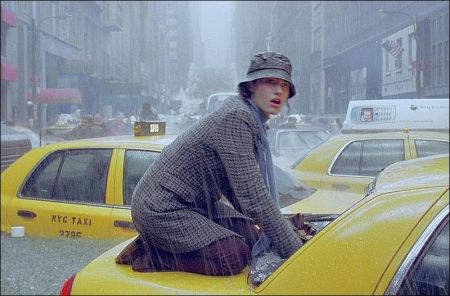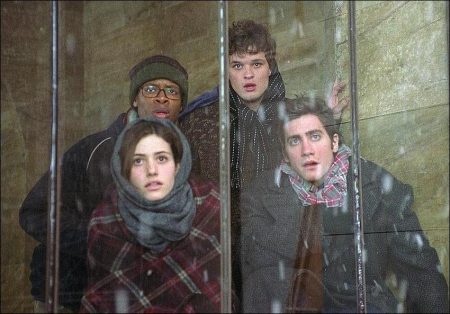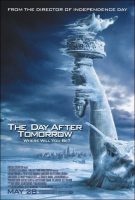Taglines: Now it’s fiction… Tomorrow it’s real.
The Day After Tomorrow movie storyline. What if we are on the brink of a new Ice Age? This is the question that haunts climatologist Jack Hall (Dennis Quaid). Hall’s research indicates that global warming could trigger an abrupt and catastrophic shift in the planet’s climate. The ice cores that he’s drilled in Antarctica show that it happened before, ten thousand years ago. And now he’s warning officials that it could happen again if they don’t act soon. But his warning comes too late.
It all begins when Hall witnesses a piece of ice the size of Rhode Island break off the Antarctic Ice Shelf. Then a series of increasingly severe weather events start to unfold around the globe: hail the size of grapefruit batters Tokyo, record-breaking hurricane winds pound Hawaii; snow falls in New Delhi, and then a devastating series of tornadoes whips through Los Angeles.
A phone call from a colleague in Scotland, Professor Rapson (Ian Holm), confirms Jack’s worst fears: these intense weather events are symptoms of a massive global change. Melting polar caps has poured too much fresh water into the oceans and disrupted the currents that stabilize our climate system. Global warming has pushed the planet over the edge and into a new Ice Age. And it all will happen during one global super storm.
While Jack warns the White House of the impending climate shift, his 17 year-old son Sam (Jake Gyllenhaal) finds himself trapped in New York City where he and some friends have been competing in a high school academic competition. He must now cope with the severe flooding and plummeting temperatures in Manhattan. Having taken refuge inside the Manhattan Public Library, Sam manages to reach his father by phone. Jack only has time for one warning: stay inside at all costs.
The Day After Tomorrow is a 2004 American science-fiction disaster film co-written, directed, and produced by Roland Emmerich and starring Dennis Quaid, Jake Gyllenhaal, Ian Holm, Emmy Rossum, and Sela Ward. The film depicts catastrophic climatic effects following the disruption of the North Atlantic Ocean circulation in a series of extreme weather events that usher in global cooling and lead to a new ice age. Filmed in Toronto and Montreal, it is the highest-grossing Hollywood film made in Canada (adjusted for inflation).
The film ranked #2 at the box office (behind Shrek 2) over its four-day Memorial Day opening, grossing $85,807,341. led the per-theater average, with a four-day average of $25,053 (compared to Shrek 2’s four-day average of $22,633). At the end of its theatrical run, the film grossed $186,740,799 domestically and $544,272,402 worldwide. It was the second-highest opening-weekend film not to lead at the box office; Inside Out surpassed it in June 2015.
The Day After Tomorrow is the eighth-highest-grossing film which did not lead the United States box office its opening weekend, behind Inside Out, Sing, My Big Fat Greek Wedding, Alvin and the Chipmunks and its sequel, Sherlock Holmes, and Ice Age: Dawn of the Dinosaurs. It is fourth worldwide in that category, behind Ice Age: Dawn of the Dinosaurs, Inside Out and Casino Royale.
About the Production
In Independence Day Roland Emmerich brought you the near destruction of the earth by aliens. Now, in THE DAY AFTER TOMORROW the enemy is an even more devastating force: nature itself.
“It’s an epic tale of survival and heroism with non-stop action and spectacular visual effects,” says producer Mark Gordon. “This movie definitely delivers the kind of visual punch audiences expect from Roland Emmerich.”
Although Emmerich’s brand of spectacle is integral to telling the story, he says the movie is not void of the human element. “No matter how big the effects are,” says Emmerich, “the heart of the movie is still human drama. The father and son characters played by Dennis Quaid and Jake Gyllenhaal are vulnerable, conflicted and loving. That’s what makes their struggle against this incredible force of nature so exciting. It’s the universal struggle of Man against Nature. It’s survival against the odds. Ultimately, it’s the triumph of the human spirit.”
“Fundamentally, this is a drama about ordinary people who find themselves struggling through extraordinary circumstances,” says co-screenwriter Jeffrey Nachmanoff. “It’s about a family trying to survive this ecological disaster. Each family member must rise to the occasion. A young man becomes a leader; a workaholic father braves everything to save his son; and a mother chooses to risk her own life to save that of a little boy. It’s a story about love, suffering and mankind’s perennial struggle to survive. “And it’s a cautionary tale about what can happen if we continue to provoke Mother Nature.”
Twentieth Century Fox’s 1996 blockbuster “Independence Day” was pure science fiction; it was not based on a widely held belief that an alien invasion was imminent. But THE DAY AFTER TOMORROW offers a scenario that is rooted in real concerns about the state of our planet.
“We pushed the time period in which an ice age could occur for dramatic purposes,” says Mark Gordon, “but the theory that global warming could cause an abrupt climate shift is gaining mainstream attention. While nobody knows what the exact result will be of mankind’s addition of carbon dioxide into the atmosphere, some experts have referred to it as ‘the largest uncontrolled scientific experiment in history.’”
The Day After Tomorrow (2004)
Directed by: Roland Emmerich
Starring: Dennis Quaid, Jake Gyllenhaal, Emmy Rossum, Ian Holm, Dash Mihok, Sela Ward, Tamlyn Tomita, Sasha Roiz, Nassim Sharara, Austin Nichols, Arjay Smith
Screenplay by: Jeffrey Nachmanoff
Production Design by: Barry Chusid
Cinematography by: Ueli Steiger
Film Editing by: David Brenner
Costume Design by: Renée April
Set Decoration by: Paul Hotte, Victor J. Zolfo
Art Direction by: Martin Gendron, Michele Laliberte, Claude Paré, Réal Proulx, Tom Reta, Gerald Sullivan
Music by: Harald Kloser
MPAA Rating: PG-13 for intense situations of peril.
Distributed by: 20th Century Fox
Release Date: May 28, 2004
Views: 119






